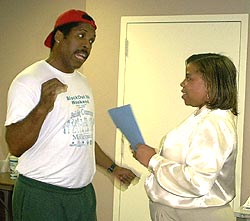
Responding to Behavioral and Motor Changes
 |
Behavioral changes that arise as HIV infection progresses may result from an underlying neurologic problem. It is important to recognize new or unusual behaviors, because often the person is in need of medical attention. For example, choking or spitting out food during meals can be the result of brain stem impairment. A change in motivation may indicate a serious mental health issue. In addition, side effects of medication, or drug or alcohol use can produce a variety of uncharacteristic behaviors. When an unusual new behavior is present in a person for whom you are caring, it is appropriate to consult the person's physician. Table 2 provides potential interventions to assist in adopting and executing health promoting patterns. |
Table 2: Behavioral Changes
|
Symptom
|
Example
|
Interventions
|
| Change in personality | Agitation/verbal outbursts. Outbursts of crying. | Avoid arguing with and aggressively confronting the person. Set guidelines for acceptable behaviors. Provide a supportive atmosphere for feelings of sadness to be shared. |
| Lack of motivation | Decreased desire to be involved in once pleasurable activities | Provide education by the person's peers. Pair people that have similar backgrounds and cultural belief systems. Ask them to share helpful techniques, talk about what works. Provide increased encouragement to engage in favorite pastimes. Help the person to schedule a time each week specifically for leisure activities. |
| Apathy | Feelings of indifference | Revive old hobbies or activities that s/he really enjoyed in the past. Find out what motivated the person in the past and learn about his/her belief system. |
| Social withdrawal | Isolation from others. Detachment from surroundings. | Encourage family/friends to visit on a one-to-one basis. Educate family/friends about dementia. |
| Loss of appetite | Avoids meals. May spit out food. Avoids social situations that are food related. | Provide favorite meals. Serve smaller portions throughout the day. Have "finger foods" and snack items handy. Consult a physician if problem persists. |
| Severe mood swings | Fear of dementia with first symptoms of forgetfulness. Suicidal thoughts | Seek medical advice/intervention from a certified mental health professional. Try to locate someone who specializes in HIV/AIDS care. |
 |
Mild to Moderate levels
of HIV-related cognitive impairment are often associated with psychomotor
slowing, a combination of slowness in movement and slowness in thought
processes (Van Gorp, Dilley, & Buckingham, 1998). In addition, some
HIV medication can cause muscle weakness and muscle atrophy. Neuropsychological
tests administered by trained healthcare professionals can help detect
the presence of HIV-Associated Dementia. Two diagnostic tests sensitive
to psychomotor slowing are the Trail Making Test and Symbol Digit Modalities
(Van Gorp, Dilley, & Buckingham, 1998).
Motor changes can impact activities of daily living. Simple tasks such as eating, grooming, and getting dressed become more difficult for those in the later stages of AIDS. When motor symptoms are prominent or become markedly worse, a call to the primary care physician and/or a neurologist is in order. Table 3 outlines helpful interventions. |
Table 3: Motor Changes
|
Symptom
|
Example
|
Interventions
|
| Muscle weakness and muscle atrophy | Fatigues easily | Help the client conserve energy by sitting down for ADL tasks such as brushing teeth. |
| Slow, unsteady movements | Difficulty maintaining balance | Remove clutter from the environment. Keep furniture in same place. Remove throw rugs/adhere rugs to floor. |
| Gait disturbances | At increased risk for falls | An evaluation by physical therapist can lead to interventions such as issuing a cane/walker and exercise programs. Encourage sitting down for ADL tasks such as brushing teeth. |
| Poor coordination | Changes/variations in handwriting; Opens pill bottles and spills contents | Using built-up handles on writing instruments/ kitchen utensils improves grasp and control. Weighted utensils are helpful in reducing tremors. Repackage items and place in easy-to-open containers. An occupational therapist can recommend environmental modifications and adapted equipment. |
| Severe psychomotor slowing | Wheelchair bound, bedridden | Range
of motion exercise can help maintain circulation and prevent muscle atrophy.
|
| Incontinence | Inability to control bladder/bowel functioning. | Create a schedule - frequent "reminders to go." |
Instant feedback
Table 4: Sensory Changes
|
Symptom
|
Example
|
Interventions
|
| Peripheral
neuropathy Numbness in the hands and feet. |
Tingling or burning sensation. Massage or warm foot baths. |
Obtain a medical evaluation. Pain should be treated by removing the offending agent or by pain management interventions. |
Instant feedback
RnCeus
Homepage | Course
catalog | Discount
prices | Login | Nursing
jobs | Help
©RnCeus.com 2008